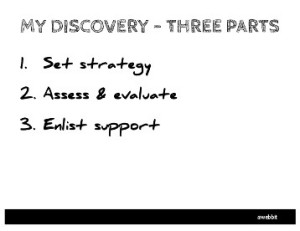Before you begin building brilliant strategies for brain injury – first a ‘Think One’ reminder.
When you are thinking about building brilliant strategies for brain injury there is:
No one strategy,
No one right way,
No one solution,
There is no one easy way!
Well that’s hardly a great start to building whiz bang strategies for brain injury!
Doesn’t seem very helpful does it?
I just believe you can save a lot of time, frustration and disappointment if you begin by understanding this.
So the first tip for building great strategies is to understand there are a lot of “mights” and no one right way when working to change the outcomes of brain injury.
 What Works and What Does Not
What Works and What Does Not
When you get a new gadget it sometimes has a disclaimer in very small print that tells you all the reasons why your gadget may not work!
Well I am going to start out here – in normal print – and tell you why your strategies for brain injury might not work.
Turn these around and it can help you build better strategies.
Understand why things DO work as well as why they DO NOT.
Terms Used Here:
Two descriptors I will use below – (note that they are completely made up by the author!)
The strategee – my word for the person who the strategy is being tried on. Most likely the person with brain injury.
The strateger – my word for the person or persons helping to put the strategy in place: Family member, support worker, self styled.
What follows are 8 reasons strategies might not work and 12 tips for developing strategies – that might work.
8 Reasons Why Your Brilliant Strategies for Brain Injury May Not Work:
Remember brilliant strategies can come from changing this list into strategies that work.
[unordered_list style=”red-x”]
- The strategee does not wish to change the outcome or behaviour. Think about something you really like to do that annoys others – would you change this just because someone told you to? I sing, often loudly, while doing my supermarket shopping no amount of strategy and encouragement from my children will have me stop – it is not my desire to change, it isn’t a priority, and I enjoy it.
- Each person is different. If each person is different then what works for one person might not work for another even with a similar outcome.
- Each person will have a unique mix of cognitive and physical abilities and difficulties. A strategy may work for one outcome but not a combination of brain injury outcomes.
- Every day is different. What works on one day may not work the next. Fatigue, weather, pain, hunger and many other factors might change responses. This article focussed on behaviour lists other factors that might influence strategies and outcomes.
- Strategies however brilliant at the beginning might not last forever. A strategy may work for a while and then become less effective or have achieved its aim for change.
- The strategy does not fit with the stratagee’s lifestyle. A young man anxious to get back to his motor-biking life and his mates, might not see personal hygiene as his priority.
- The strategee has not been involved in working out what might work and how to implement the strategy.
- Persisting with consistency and routine when it is really not working. Sometimes as strateger you need to forget consistency and routine and change the strategy.
- The strategy being implemented by the strateger is too restrictive, creating other difficulties
[/unordered_list]
12 Tips To Develop Strategies for Brain Injury That Are Helpful:
The most brilliant strategies are:
[ordered_list style=”decimal”]
- Custom made: design strategies that are tailored to the person; lifestyle, family life, friends, interests and motivation. Strategies need to fit with life, not just the outcome of brain injury. It is important to consider the WHOLE picture.
- Focussed on What’s Important: Work together to find out the area of focus that is a priority for the strategee and their life.
- Prioritised: The most important areas to work on are sorted with the person living with brain injury their family and supporters. Begin with one or two priority issues at a time.
- Feasible: Make sure any resources needed to implemented the strategy are available.
- Clear and focussed: The KISS principle is useful– keeping it simple, clear, doable.
- Age and stage appropriate: Check the strategies reflect the person’s age and stage. An adult needs grown up strategies; a child needs developmental strategies for their age; an adolescent needs strategies that take into account their teenage needs, changes and fluctuations.
- Built on prior skills and knowledge: A person with brain injury will most often have much of the knowledge and many of the skills from before the illness or injury. Start with this.
- Strengths based: Build from what a person is good at. Find what works well; find the strengths and build on them. Strengths might be within the person, and their family, past experiences, resources available.
- Motivating: Seek out what motivates the stratagee. Most of us are more likely to be successful in making a change if we are motivated to change. What aspects does the person want to do differently? What may be stopping them achieving their goals – start with these.
- Based on knowledge of Brain Injury: Understand as much as possible about brain injury and the outcomes of brain injury for the stratagee. Use this in developing the most appropriate strategies.
- Flexible: Change when needed. Depending on the combination of outcomes you may need a different set of strategies, for example if a person has inappropriate behaviour and short term memory problems using “time out’ may not be the best strategy as the person may not remember why they are excluded.
- Reviewed regularly: Set regular times to look at whether the strategy is working and what needs tweaking.
[/ordered_list]
 A Resource With A Difference
A Resource With A Difference
The following article I found interesting and useful in thinking about strategy. This is not focussed on brain injury yet it contains some helpful ideas for developing strategy. I was drawn in by the interesting title – “Doors + Walls + Old Trees” the presentation is more about business but I hope you might find some useful tips.
And Finally
This has been a brief look at another big topic of brain injury. Strategies are a key. Developing and implementing good strategies for brain injury is fundamental to the success of a person living with the outcomes of brain injury and wanting to return to, or continue their life.
Don’t be afraid to get help – enlist help, support, and advocacy where needed from people with experience.
Next week a set of principles to help your brilliant strategies shine like diamonds!


Excellent article Mel. Strategies such as these are useful for many people too – not just those with brain injuries. So, an excellent read for many folk.
Thank you Sandra for feedback. You remind us that we find strategies that can be effective in many different situations.
Pingback: Strategies for Organisation Planning and Problem Solving After Brain Injury - Changed Lives New Journeys